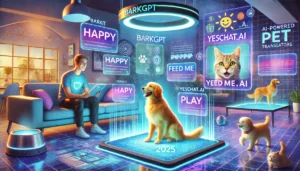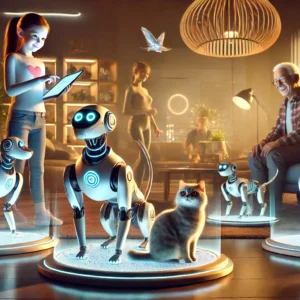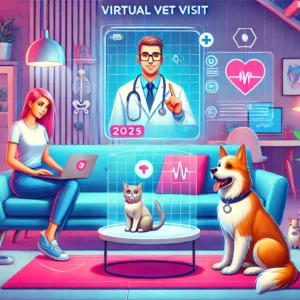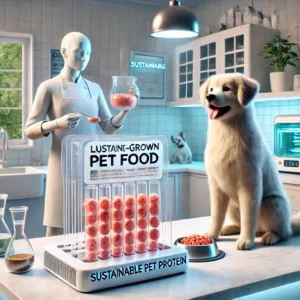
In 2025, technology and our love for pets have converged in fascinating ways. Among the most groundbreaking innovations are AI-powered pet translators, devices and apps designed to decode barks, meows, and even body language into meaningful human communication. These gadgets are turning science fiction into reality, bridging the gap between humans and their furry companions.
As we dive into the world of AI pet translators, let’s explore the latest advancements, societal implications, and voices shaping this exciting frontier.
The Rise of AI Pet Translators
AI pet translators use sophisticated algorithms and machine learning models to analyze vocalizations, behaviors, and body movements of animals. Devices like BarkGPT and PetSpeak are leading the charge, claiming to interpret emotions like happiness, anxiety, or even hunger. For instance:
- BarkGPT uses deep learning to analyze dog barks in real time, categorizing them into emotional states.
- Apps like YesChat.AI Animal Translator and Pet Decoder provide insights into what your pets might be trying to communicate.
With user-friendly interfaces and growing databases, these tools promise to make pet ownership more intuitive and empathetic.
Government and Political Perspectives
Governments worldwide are taking note of the potential these tools have to improve animal welfare. In the U.S., the Department of Agriculture has shown interest in funding research that enhances human-animal communication, particularly for service animals. Similarly, the European Union has proposed grants under its Horizon Europe program to explore ethical AI usage in pet care.
However, concerns over data privacy and the ethical use of AI have led to calls for regulation. In 2024, a parliamentary debate in the UK highlighted the need for transparency in AI-driven animal data collection, emphasizing that it must not exploit pet owners or compromise animal welfare.
What Scientists and Research Labs Are Saying
Leading research labs, such as MIT’s Media Lab and Germany’s Fraunhofer Institute, are at the forefront of studying animal communication. Dr. Sarah Greenfield, an ethologist at MIT, notes:
“AI translators are not just about understanding words. They analyze tone, pitch, and context, creating a multidimensional map of animal emotions.”
Studies have shown promising results in decoding canine communication, with an 80% accuracy rate in detecting emotions. However, scientists caution that interpreting animal behavior involves nuances that AI may oversimplify.
Celebrity Endorsements and Public Fascination
Hollywood has embraced this trend wholeheartedly. Celebrities like Chris Evans and Taylor Swift, known for their love of pets, have publicly supported AI translators. Evans recently tweeted:
“Finally, I can stop guessing what Dodger’s barking means. Thanks to BarkGPT for giving me a window into his world!”
Meanwhile, influencers are sharing heartwarming stories of how these tools have deepened their bonds with pets. Videos showcasing AI devices translating a pet’s excitement or concern have gone viral, drawing millions of views on platforms like TikTok and Instagram.
Social and Generational Views
Older Generations
For older pet owners, AI translators are a blessing. Many report that these tools help them better care for their pets, especially when physical limitations make it challenging to interpret body language.
“At 70, I rely on my pet translator to understand Bella’s needs. It’s like having a second set of ears,” shares Margaret, a retired teacher.
Younger Generations
Younger audiences see AI pet translators as both practical and fun. Millennials and Gen Z pet owners use these devices to create playful content, imagining conversations with their pets.
However, there’s a deeper resonance among these groups. Many view AI pet translators as tools for fostering empathy and advocating for animal rights. The technology aligns with their values of innovation and compassion.
The Global Market for AI Pet Translators
The global market for AI pet translators is booming, with a projected revenue of $2 billion by 2026. Major tech players like Google and Amazon are investing heavily in this niche, while startups are entering the scene with innovative solutions.
- Revenue Sources: Subscription-based apps, smart collars, and integrations with home assistants.
- Key Markets: North America, Europe, and Asia-Pacific are leading the adoption curve, with rising interest in urban centers.
This growth reflects not just demand but a cultural shift toward prioritizing pets as family members.
Ethical Considerations and Challenges
While the potential is enormous, AI pet translators face challenges:
- Accuracy: No tool is 100% accurate, and misinterpretations can lead to confusion.
- Privacy: Data collected by these devices raises questions about user and pet privacy.
- Ethical Boundaries: Critics argue that interpreting emotions doesn’t equate to full communication, warning against anthropomorphism.
Governments and tech leaders must navigate these concerns to ensure responsible innovation.
FAQs About AI-Powered Pet Translators
Q: Can AI pet translators understand all animals?
A: Most tools focus on common pets like dogs and cats, but research is expanding into birds, horses, and even exotic species.
Q: Are these devices reliable?
A: While promising, current tools have an accuracy rate of 70-80%. Continuous updates are improving their performance.
Q: Do these tools work offline?
A: Many require internet access to analyze data and connect to cloud-based AI models.
Q: Are they expensive?
A: Prices vary, with apps starting at $5/month and advanced devices costing upwards of $200.
The Future of AI in Animal Communication
Looking ahead, the integration of AI pet translators with smart home ecosystems could revolutionize pet care. Imagine a world where your dog’s collar notifies you of their mood or a smart feeder adjusts portions based on their stress levels.
As AI continues to evolve, the dream of a deeper connection with our pets feels closer than ever. Whether you’re an enthusiast, a skeptic, or somewhere in between, one thing is certain: AI-powered pet translators are reshaping how we perceive and care for our furry companions.




